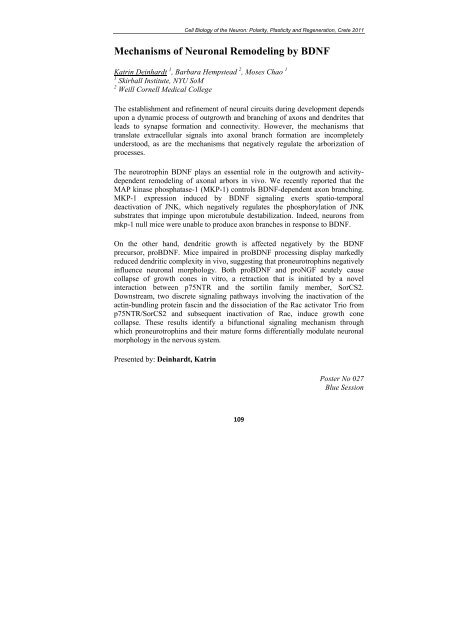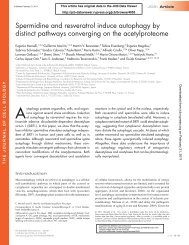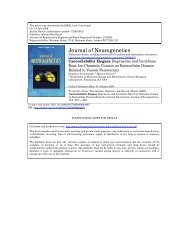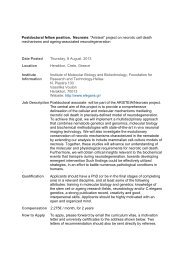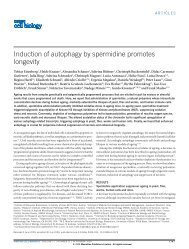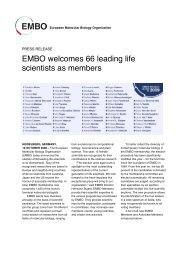CELL BIOLOGY OF THE NEURON Polarity ... - Tavernarakis Lab
CELL BIOLOGY OF THE NEURON Polarity ... - Tavernarakis Lab
CELL BIOLOGY OF THE NEURON Polarity ... - Tavernarakis Lab
Create successful ePaper yourself
Turn your PDF publications into a flip-book with our unique Google optimized e-Paper software.
Cell Biology of the Neuron: <strong>Polarity</strong>, Plasticity and Regeneration, Crete 2011<br />
Mechanisms of Neuronal Remodeling by BDNF<br />
Katrin Deinhardt 1 , Barbara Hempstead 2 , Moses Chao 1<br />
1 Skirball Institute, NYU SoM<br />
2 Weill Cornell Medical College<br />
The establishment and refinement of neural circuits during development depends<br />
upon a dynamic process of outgrowth and branching of axons and dendrites that<br />
leads to synapse formation and connectivity. However, the mechanisms that<br />
translate extracellular signals into axonal branch formation are incompletely<br />
understood, as are the mechanisms that negatively regulate the arborization of<br />
processes.<br />
The neurotrophin BDNF plays an essential role in the outgrowth and activitydependent<br />
remodeling of axonal arbors in vivo. We recently reported that the<br />
MAP kinase phosphatase-1 (MKP-1) controls BDNF-dependent axon branching.<br />
MKP-1 expression induced by BDNF signaling exerts spatio-temporal<br />
deactivation of JNK, which negatively regulates the phosphorylation of JNK<br />
substrates that impinge upon microtubule destabilization. Indeed, neurons from<br />
mkp-1 null mice were unable to produce axon branches in response to BDNF.<br />
On the other hand, dendritic growth is affected negatively by the BDNF<br />
precursor, proBDNF. Mice impaired in proBDNF processing display markedly<br />
reduced dendritic complexity in vivo, suggesting that proneurotrophins negatively<br />
influence neuronal morphology. Both proBDNF and proNGF acutely cause<br />
collapse of growth cones in vitro, a retraction that is initiated by a novel<br />
interaction between p75NTR and the sortilin family member, SorCS2.<br />
Downstream, two discrete signaling pathways involving the inactivation of the<br />
actin-bundling protein fascin and the dissociation of the Rac activator Trio from<br />
p75NTR/SorCS2 and subsequent inactivation of Rac, induce growth cone<br />
collapse. These results identify a bifunctional signaling mechanism through<br />
which proneurotrophins and their mature forms differentially modulate neuronal<br />
morphology in the nervous system.<br />
Presented by: Deinhardt, Katrin<br />
109<br />
Poster No 027<br />
Blue Session


